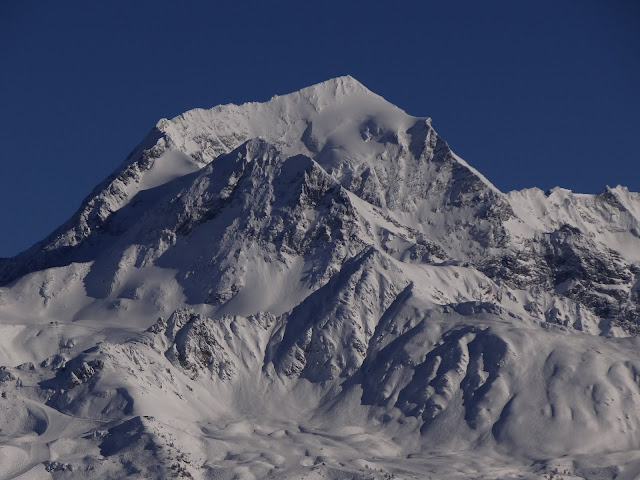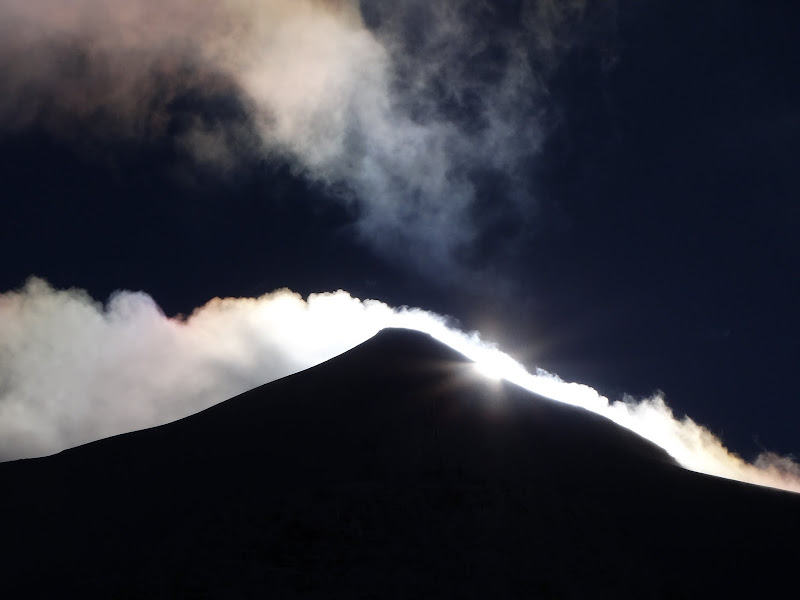Went skiing with Gareth today. It was the usual madness. Just a casual prompt from me “Oh Look! There are tracks heading off down there!” And off he goes into the unknown. Remind me why I never like following anyone! I’d rather however be obliged to follow Gareth’s randomness than any official “off-piste” guide – because that’s a real game of Russian Roulette. The following quote applies well here: "Science is the belief in the ignorance of the experts" – Richard Feynman. Just replace “Science” with “Survival”!
The Avalanche Barrier Song
We did end up with some great untracked snow between the trees and working with chi-skiing it was real fun making tight turns. Gareth is pretty good at heaving his massive belly around tight turns too – but he is always very close to splatting against something. The last time he got near avalanche barriers he splatted against those and broke his back. Fatefully all the paths here converged on a narrow chute filled with avalanche barriers. The snow was rotten at a certain depth because it took the sun there. I opted for safety and started to try to climb back up – but the snow was too soft and deep to avoid a major effort. Gareth gave in to his fatness and pleaded the case that skiing it would be better than climbing – probably by assessing the risk of heart attack. After 5 minutes of sinking to my waist in the snow I agreed. I’d given Gareth a transceiver, but not so I could find him if he got buried – it was so he could find me if anything happened. I had the complete kit including air bag. The only thing I didn’t have was my “Avalung” breathing tube – which I’ve only ever used when heliskiing in deep powder. This was one situation where a full jet pack with self-orienting vertical take off capacity would have been desirable. As it happened we found a couple of relatively safe passages around the barriers where there were trees that had survived a good dozen years or more. Considering that Gareth had a migraine because of his stressful lifestyle and I was feeling a bit stiff and unmotivated we did pretty well. It’s the first time I’ve used full chi-skiing technique in the trees or tricky steeps so it was very interesting and good fun.
The Missing Link
After returning to Tignes we agreed to continue skiing and went up the Grande Motte. Launching myself onto a steep off-piste pitch, untracked and through the rocks I was hesitant again with the real steepness. I explained to Gareth that it was bugging me that I couldn’t get the 100% control that I wanted when initiating a turn on the steep from a static start. I know that when I have some speed – if the outcome is guaranteed to be safe – then I have no difficulty. Somehow the tension in the body was inhibiting the static start on the steep ground and my conscious efforts to overcome it were not doing the job properly. Gareth just told me to get on with it so I did. Two smooth turns later I stopped, unhappy at the slight excess of speed. Gareth probably just thought that I’d managed two nice smooth turns but I wasn’t happy. Then Gareth launched himself into turn number one and almost went over the front of his skis – compressing his knee in the process and hurting his leg. Turn number two was a sort of linked recovery – minus the usual Gareth headplant or cartwheel. He then managed another fairly tight turn and bailed out accelerating past me in a straight line yelling something resembling “Mayday, Mayday….” Apparently my turns had mistakenly led him to believe the snow was nice and skiable – but it was far from it. One more steep pitch and he spotted the missing ingredient! I was forgetting to retract! In the effort to either generate pressure or to jump from a stationary I was losing the normally reflexive retraction which stops you from popping up too high after the body is lifted up out of the turn. It was too steep to just fall over into the turn as in a compression turn – for fear of the the skis not making it round to follow the body. Once that was identified I added it to the mix and sure enough even gnarly steep snow became easy again. Gareth has been a pro for about 30 years and it’s the first time I’ve had anyone manage to give me useful feedback for about 17 years! Ironically it was me who showed Gareth how to retract and fall into a turn using dynamics – but not on neck breaking steepness – which is Gareth’s natural headplanting domain.
Chi-Skiing
It’s safe to say following Gareth’s display of linked recoveries that every run we did was on terrain where I’ve never taken a client. I’d be more nervous for their safety than my own. It’s very unnerving watching your client cartwheeling past you or acting like a luge face first down a couloir without skis. Fortunately I’ve never once managed to get a client into an avalanche – all those other things yes – but never buried! Most injuries I’ve seen have actually taken place on green or blue slopes! Perhaps the flatter ground causes a greater impact? Yes that must be right. Green slopes are more dangerous. Gareth’s problem now appears to be simple to me and something that can be relatively easily solved. We tried many things over the years but nothing worked, because the root of his technical problem was well hidden. The answer is in chi-hips! All Gareth has to do is hold his feet and shoulders steady while pulling back the outside (of the turn) hip. This integrates the upper and lower body instead of “separating” them and it prevents his hip rotation and the outside foot from trailing – which together cause his troubles. Gareth tried this on the piste with carving and the difference was noticeable to me as he could get much lower to the ground with hip angulation and the foot was trailing much less. He couldn’t hold it together off-piste though, but that’s normal when learning something new. Gareth could feel the spine twist appropriately and understand the full chi-skiing action. Until this season I couldn’t teach this in such a clear and uncomplicated manner – but confidence in seeing the dramatic improvement of other skiers with it – and isolating the essentials - have gradually altered my own perception of this issue.

















































